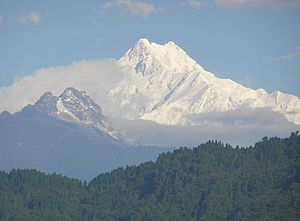Kangchenjunga is the third highest mountain in the world.[3] It rises with an elevation of 8,586 m (28,169 ft) in a section of the Himalayas called Kangchenjunga Himal that is limited in the west by the Tamur River and in the east by the Teesta River.[1] Kangchenjunga is located on the boundary between Nepal and the Indian state of Sikkim.[4]
The Geological Survey of India indicates the summit of Kangchenjunga at 8,598 m (28,209 ft).[5] It is the highest peak in India and the easternmost of the peaks higher than 8,000 m (26,000 ft). It is called Five Treasures of Snow after its five high peaks, and has always been worshiped by the people of Darjeeling and Sikkim.[6]
Two of the five peaks are in Taplejung District, Nepal.[7] The other three peaks – main, central, and south – are on the border of North Sikkim and Nepal.
Until 1852, Kangchenjunga was assumed to be the highest mountain in the world, but calculations based on various readings and measurements made by the Great Trigonometric Survey of India in 1849 came to the conclusion that Mount Everest, known as Peak XV at the time, was the highest. Allowing for further verification of all calculations, it was officially announced in 1856 that Kangchenjunga is the third-highest mountain.[8]
Kangchenjunga was first climbed on 25 May 1955 by Joe Brown and George Band, who were part of a British expedition. They stopped short of the summit as per the promise given to the Maharaja of Sikkim that the top of the mountain would remain inviolate. Every climber or climbing groups that have reached the summit have followed this tradition
Names
Kangchenjunga is the official spelling adopted by Douglas Freshfield, A. M. Kellas, and the Royal Geographical Society that gives the best indication of the Tibetan pronunciation.[3]
The brothers Hermann, Adolf and Robert Schlagintweit explained the local name Kanchinjínga meaning “The five treasures of the high snow” as originating from the Tibetan word "gangs" /kang/ meaning snow, ice; "chen" /ʧen/ meaning great; "mzod" meaning treasure; "lnga" meaning five.[9] The treasures represent the five repositories of God, which are gold, silver, gems, grain, and holy books.[citation needed]
There are a number of alternative spellings which include Kangchen Dzö-nga, Khangchendzonga, Kanchenjanga, Kachendzonga, Kanchenjunga or Kangchanfanga. The final word on the use of the name Kangchenjunga came from His HighnessSirTashi Namgyal, the Maharaja or chogyal of Sikkim, who stated that "although junga had no meaning in Tibetan, it really ought to have been Zod-nga (treasure, five) Kang-chen (snow, big) to convey the meaning correctly". Following consultations with a Lieutenant-Colonel J.L.R. Weir, British agent to Sikkim, he agreed that it was best to leave it as Kangchenjunga, and thus the name remained so by acceptance and common usage.[citation needed]
Kangchenjunga's name in Nepali is कञ्चनजङ्घा Kanchanjaŋghā. Its name in the Limbu language is Sewalungma, meaning "mountain to which we offer greetings". Sewalungma is considered sacred by adherents of the Kirant religion.[citation needed]
Protected areas
The Kangchenjunga landscape is a complex of three distinct ecoregions: the eastern Himalayan broad-leaved and coniferous forests, the eastern Himalayan alpine meadows and the Terai-Duar savannas and grasslands.[10] The Kangchenjunga transboundary landscape is shared by Bhutan, China, India and Nepal, and comprises 14 protected areas with a total of 6,032 km2 (2,329 sq mi):[11]
- Kanchenjunga Conservation Area located in Nepal;
- Torsa Strict Nature Reserve located in Bhutan.
These protected areas are habitats for many globally significant plant species such as rhododendrons and orchids and many endangered flagship species such as snow leopard, Asiatic black bear, red panda, Himalayan musk deer, blood pheasant and chestnut-breasted partridge.[11].[6]

